Martin Gardner's Puzzle Books
Scientific American Puzzles
Mathematical and Logic Puzzles
Word Play Puzzles
Science Fiction Puzzles
Science Puzzles
Edited Puzzle Collections
Other Puzzle Offshoots
Optical Illusions
Puzzlers on National Public Radio
Curiously, despite Martin's reputation as a puzzle master, he didn't see himself as a good puzzler solver or as a puzzle creator, but rather as a conduit for sharing puzzles conceived (or passed on) by others. In 2009, he told John Tierney New York Times, "The number of puzzles I've invented you can count on your fingers," which was probably an underestimate, but his observation is at least partially true. He generally credited the inventors and true sources of the wonders he wrote about, when known.Martin published over 40 collections of puzzles in the 52-year period from 1959 to 2010. Many of the earlier volumes resurfaced decades later thanks to new publishers, often updated, and under new titles.
The great majority of the puzzles which Martin wrote about were logical, mathematical or scientific in some way, but he also loved visual and wordplay challenges.
Over 60 of his puzzles can be found online at the Puzzles.com
puzzles and brainteasers site.
Martin Gardner's Scientific American Puzzle Collections
Martin is most famously associated with the puzzles posed in his 300-odd Scientific American columns, and the fifteen resulting books which appeared between 1959 and 1997. Of course, those columns and books contained much material not in the puzzle vein.The puzzles that did feature in the Scientific American columns range from being merely thought-provoking to linking to deeper concepts. Here we list the Scientific American spin-offs which focus on items of particular interest to puzzle lovers.
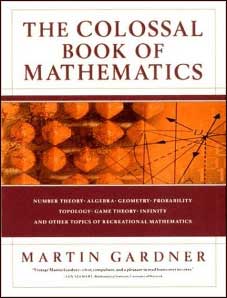
The Colossal Book of Mathematics: Classic Puzzles, Paradoxes, and Problems (W.W. Norton, 2001, 10 + 724 pages) was compiled by Martin himself. In the Preface, he writes, "Robert Weil, my editor at W.W. Norton, suggested that I select 50 of what I consider my 'best' [Scientific American] columns, mainly in the sense of arousing the greatest reader response, to make this hefty, and in terms on my career, definitive book you now hold."
The updated columns are organized into 12 chapters: Arithmetic and Algebra, Plane
Geometry, Solid Geometry and Higher Dimensions, Symmetry, Topology, Probability,
Infinity, Combinatorics, Games and Decision Theory, Physics, Logic and Philosophy,
and Miscellaneous. They include,
"The Monkey and the Coconuts,"
"Rep-Tiles,"
"Penrose Tiles,"
"Packing Spheres,"
"Hypercubes,"
"The Amazing Creations of Scott Kim,"
"The Art of M.C. Escher,"
"Knots,"
"Nontransitive Dice and Other Paradoxes,"
"Surreal Numbers,"
"Hexaflexagons,"
"The Soma Cube,"
"The Game of Life,"
"The New Eleusis,"
"Time Travel,"
"The Unexpected Hanging,"
"Newcomb's Paradox,"
"Gödel, Escher, Bach"
and
"Six Sensational Discoveries."
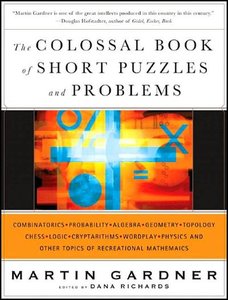
The Colossal Book of Short Puzzles and Problems (W.W. Norton, 2005, 8 + 496 pages) was compiled and edited by Dana Richards. Its 17 chapters, ranging from Combinatorics to Physics, are divided into 4 parts: Combinatorial & Numerical, Geometric, Algorithmic and Other Puzzles. There's an appendix called "Twelve More Brain Teasers," which includes "Three Switches" (which made it onto NRP's Car Talk), "Inscribed Square" (a puzzle Martin gave to Marilyn vos Savant for her Parade column in 1999), "Toothpick Giraffe" (featured in 2009 in Numberplay in the New York Times), "Unattacked Queens," and "100 to CAT" (also featured in the NYT).
Mathematical and Logic Puzzles
In addition to the 20 main Scientific American books and spin-offs, Martin published about 25 other books of puzzles, some aimed at children.
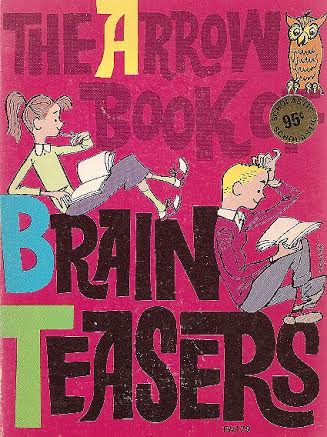
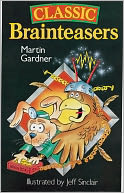
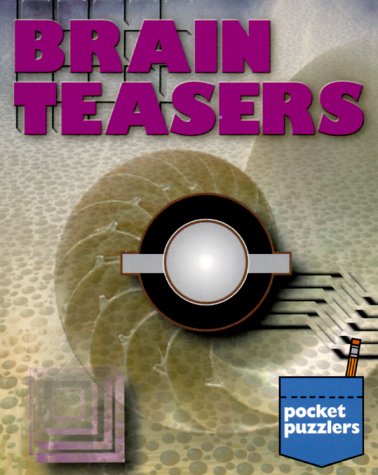
The Arrow Book of Brain Teasers (Scholastic Book Services, 1959, 64 pages, charmingly illustrated by William Hogarth) was first out the gate, containing over 60 items. The Arrow series of books published (and promoted in schools) by Scholastic Book Services was specifically aimed at grades 4, 5, & 6. Delightful word puzzles, riddles, and visual illusions are mixed in with "spot the error" headscratchers and teasers about science, knots and counting triangles and squares. Mathematical results about the graph K3,3, Eulerian circuits, the permutation group on 3 objects, and the maximal number of pieces a disc can be cut into with 4 straight cuts, as well as the pigeonhole principle, are sneaked in unsuspected.
"The Colored Socks" (still doing the rounds today, e.g., see New York Times "Numberplay"), "Find the Missing Piece" (the optical illusion involving a slice of cheesecake or pie), and "Lewis Carroll's Squares" all appear, as does a variation on the classic about connecting three houses to three utilities. Page 26 shows two spacemen exploring the surface of the moon, a full decade before such a thing came to pass.
In the mid 1990s, this book was reworked as Classic Brainteasers (Sterling, 1994, 96 pages, illustrated by Jeff Sinclair), with many of the puzzles tweaked.
A few years later, the same publisher combined some of this material with excerpts from other books by George J. Summers, Robert Steinwachs, and Edward J. Harshman, for Brain Teasers (2000, 96 pages).
Science Puzzlers (Viking, 1960) treated below also has excellent
mathematical puzzles.
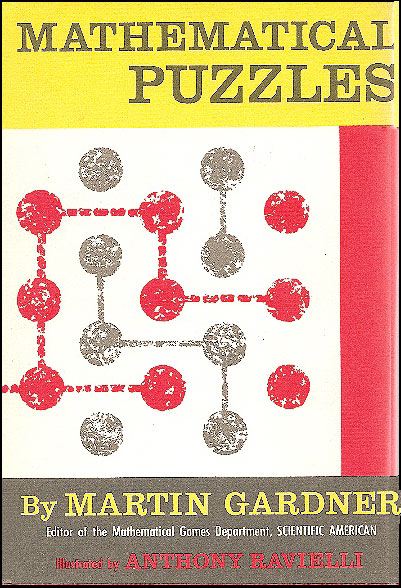
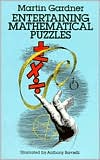
Mathematical Puzzles (Crowell, 1961, 12 + 112 pages, illustrated by Anthony Ravielli) came next. It's broken up in 9 parts contained 39 puzzles, plus 28 "short and easy" items in a final part called Tricky Puzzles.
The earlier parts grouped problems by type, under the heading Arithmetic, Money, Speed, Plane Geometry, Solid Geometry, Game, Probability, Topology, or Miscillaneous Puzzles, and include brief essays on each topic. Unusually, by later standards, the solution to each problem is given immediately after it is posed.
In due course, this book resurfaced as Entertaining Mathematical Puzzles (Dover, 1986).
In the Introduction, Martin reveals that many of the puzzles had appeared in his
column "On the Light Side" which ran in Science World. (He wrote 40 of
those between Feb 1957 and May 1959). The first problem is "The Colored Socks",
still doing the rounds today (see New York Times
"Numberplay").
Next up is "Weighty Problem," a variation of which can be
found at
www.puzzles.com. Other evergreen classics such as "The Bicycles and the Fly,"
"Corner to Corner" (see
"Rectangle Around"), "Outside or Inside" (see "In 'n" Out"),
and
"Six Numbers" appear, alongside Paul Curry's vanishing area squares, Mobius
band surprises, and truthtellers and liars.
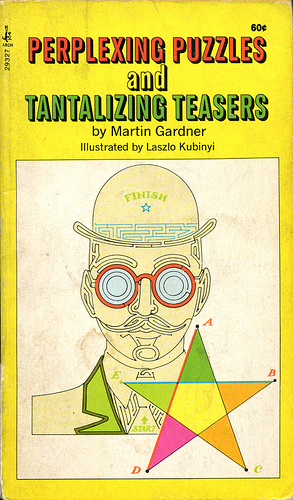

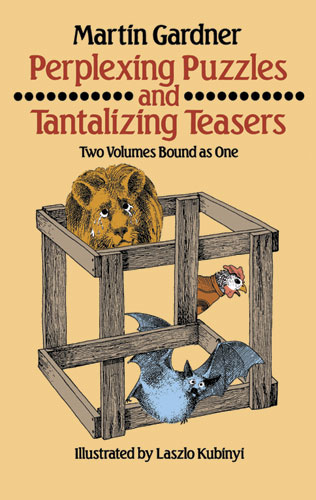
Perplexing Puzzles and Tantalizing Teasers (Simon and Schuster, 1969, 96 pages, illustrated by Laszlo Kubinyi) contained 47 puzzles, and was included in the New York Times list of Outstanding Books of the year on 9 Nov 1969.
More Perplexing Puzzles and Tantalizing Teasers (Archway, 1977, 8 + 119 pages), contained 46 more. These were later combined in a single volume as Perplexing Puzzles and Tantalizing Teasers (Dover, 1988, 223 pages).
These books contain a lot of riddles, alongside mazes, optical illusions and other visual gags, and some mathematical material. The second volume ends with a then-rare "identify the pixilated portrait" question.
The last problem in the first book is the ever-popular "Shake Out the Cherry,"
learned from Fujimura (see below),
a version of which can be found at
www.puzzles.com.
The 1977 book includes
"The Two Spirals,"
"Find the Center," and another Fujimura classic, here dubbed "The Fish That
U-Turned" (see
"Turn the Fish.")
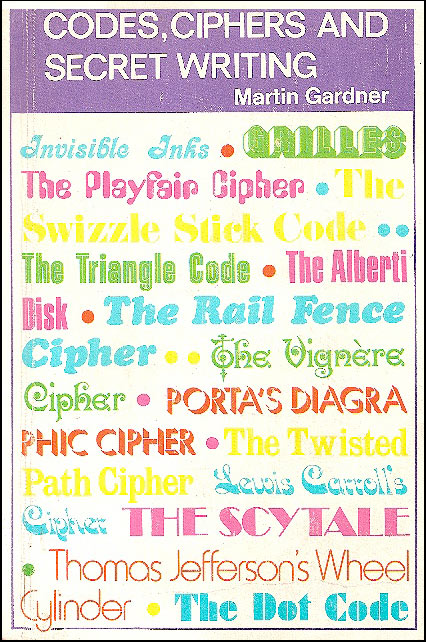
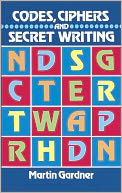
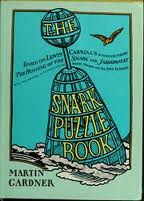
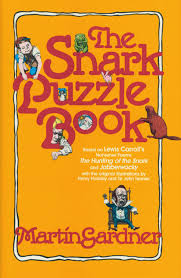
Along the way, there was Codes, Ciphers, and Secret Writing (Simon and Schuster, 1972, and Dover, 1984, 96 pages), and The Snark Puzzle Book (Simon and Schuster, 1973, and Prometheus, 1990, 125 pages).
The first, appearing just a few years before cryptography was totally revolutionized by RSA methods—a story Martin himself broke to the general public— has child-friendly chapters on substitution and polyalphabetic ciphers, in addition to old-fashioned methods including invisible writing.
The second was subtitled, "Based on Lewis Carroll's Nonsense Poems The Hunting of
the Snark and Jabberwocky with the original illustrations by Henry Holiday and
Sir John Tenniel."

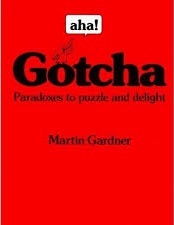
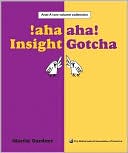
Two of Martin's more popular puzzle books were Aha! Insight (Scientific American/W. H. Freeman, 1978, 8 + 179 pages, illustrated by Jim Glen and Felix Cooper), and aha! Gotcha: Paradoxes to puzzle and delight (W. H. Freeman, 1982, 10 + 164 pages, illustrated by Jim Glen, Ray Salmon, and Scott Kim), later updated and combined as Aha! Gotcha Aha! Insight (MAA, 2006).
The origins of the material in these books is explained in Fernando Q. Gouvêa's review at MAA.org,
"In the mid-1970s, Martin Gardner and Robert Tappay came up with the idea of producing filmstrips for use in high school classrooms, one about mathematical paradoxes and one about mathematical problems that can be solved easily provided one has just the right insight. The strips featured illustrations by Jim Glen; they were marketed as 'The Paradox Box' and 'The Aha! Box.'Of course, what Gardner and Tappay didn't realize (hardly anyone did, at the time) was the filmstrip was already dead, about to be replaced by fancier technologies such as video. So the two 'boxes' were transformed into books."
The 65 problems in Aha! Insight are spread out over six chapters (Combinatorial, Geometry, Number, Logic, Procedural, and Word aha!). This is perhaps the most sophisticated of Martin's puzzle books. Many classic puzzles reappear wrapped up in inventive new storylines—followed immediately by solutions—before generalizations are suggested, and detailed analysis is presented.
Aha! Gotcha: Paradoxes to puzzle and delight is also divided into six chapters (Logic, Number, Geometry, Probability, Statistics, and Time). It contains 80 headscratchers ranging from all cretans are liars, truth tellers and liar scenarios, infinity, and vanishing leprechauns, to the gambler's fallacy, Pascal's wager, and Newcomb's paradox.
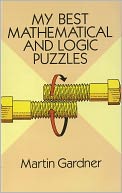
My Best Mathematical and Logic Puzzles (Dover, 1994, 8 + 82 pages), contains 66 items, and is one of Martin's best-known collections.
In his Introduction, he writes:
"During the twenty-five years that I had the great privilege of writing the Mathematical Games column in Scientific American, my practice was to devote a column, about every six months, to what I called short problems or puzzles.... [] the puzzle columns were reprinted in book collections.Most of the problems in this book are selected from the first three collections. The last 12 puzzles are selected from two articles I contributed to Games magazine []."
Classic puzzles featured include "The Returning Explorer" (aka the generalized "What Color Is the Bear?"), "The Mutilated Chessboard," "The Fork in the Roada" (liars and truth-tellers), "Cutting the Cube," "The Counterfeit Coins," "The Touching Cigarettes," "Hole in the Sphere," "The Twiddles Bolts," "The Colliding Missiles," "The Sliding Pennies," "Water and Wine," "A Fixed-Point Theorem" (aka "The Buddhust Monk"), "Out With the Onion" (aka "A Cherry and a Glass"), and "Crazy Cut."

The Universe in a Handkerchief: Lewis Carroll's Mathematical Recreations, Games, Puzzles, and Word Plays (Copernicus/Springer-Verlag, 1996, 10 + 158 pages) surveys the topics indicated by its title in the chapters Fiction and Verse, The Diaries, Letters, Books and Articles, Miscellaneous Amusements, Doublets, and Pamphlets on Games.
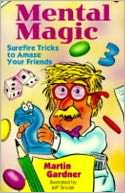
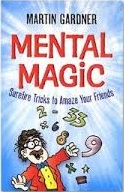
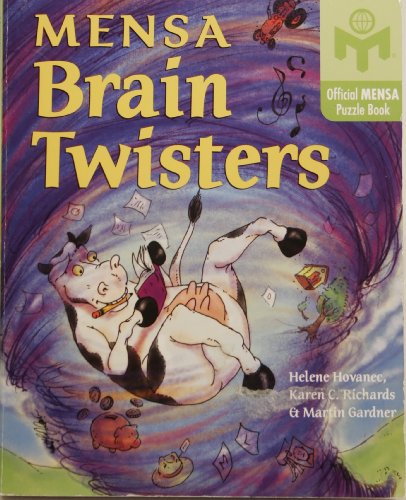
Mental Magic (Sterling, 1999, Dover, 2010, 95 pages, illustrated by Jeff Sinclair) is subtitled "Surefire Tricks to Amaze Your Friends." Its 89 predictive items are seemingly aimed at a young audience, and range from simple gags and forces with words, cards, dice and calculators, to classics by Bob Hummer, Paul Curry, George Sands, Max Maven, and Karl Fulves, as well as Jim Steinmeyer's "Nine Card Speller" from 1993. Much of the material is far from juvenile, such as the first trick: a word-based version of the Kruskal Count.
Sterling included this entire book, repaginated, as pages 5–114 of Mensa Brain Twisters, under their Main Street imprint (2004, 286 pages). Denoted "Official MENSA Puzzle Book," the level of its puzzles seems far short of MENSA standards. The rest of the book was drawn from earlier books by Helene Hovanec and Karen C. Richards.
Word Play Puzzles
For Martin, a wordplay puzzle coule be just as much fun as a mathematical one. Here's an elementary visual one that Martin was very fond of.
Can you change 100 below into CAT by moving two toothpicks? Martin was a lifelong fan of wordplay, and contributed frequently to Word Ways: The Journal of Recreational Linguistics, a quarterly magazine "established in 1968 at the behest of Martin Gardner."

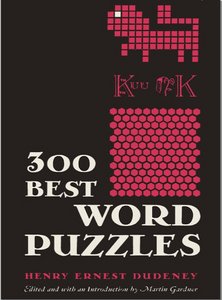
His edited version of Dudeney's book The World's Best Word Puzzles (The Daily News, 1925) appeared as 300 Best Word Puzzles by Henry Ernest Dudeney (Scribner's Sons, 1968, 12 + 172 pages), "edited and with an introduction by Martin Gardner." The sixteen chapters range from Enigmas or Riddles, Conundrums, Acrostics, and Charades, to Word Chains and Rings, Squares, Stars, Cross-Word Puzzles, and Miscellaneous Puzzles.
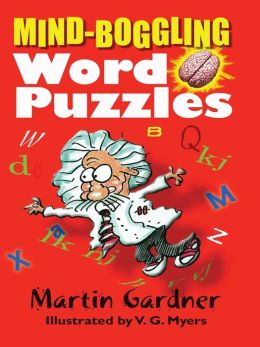
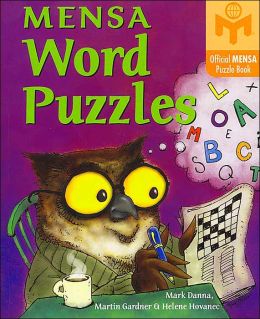
Mind-Boggling Word Puzzles (Sterling, 2001, Dover, 2010, 96 pages, illustrated by V. G. Myers), contained 103 items, ranging from riddles and visual effects with letters and words to palindromes, rebuses, crosswords, and anagrams.
A few years later, the same publisher included 70 of them as the third part of the Mensa Word Puzzles under their Main Street imprint (2004, 287 pages). Denoted "Official MENSA Puzzle Book," the level of its puzzles seems far short of MENSA standards. It was cobbled together from earlier books by Helene Hovanec, Mark Danna, and Martin.
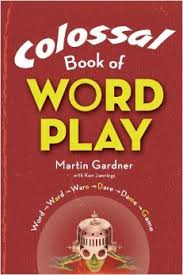
A few months after Martin died, there appeared the jam-packed yet misnamed Colossal Book of Wordplay (Puzzle Wright Press/Sterling, 2010, 160 pages), edited by Ken Jennings, who also added some material. (The front cover artwork makes it look as if "Wordplay" is two words, but the spine shows it as one.) It's broken up into six chapter: Palindromes, Anagrams, and Other Whimsies, Perplexing Puzzles and Curious Conundrums, Bizarre Poems, Brief Brain Busters, Entangled Word and Numbers, and Conjuring With Words. A taster from this had appeared in Word Ways in 2007 as "Linguistic Catches."